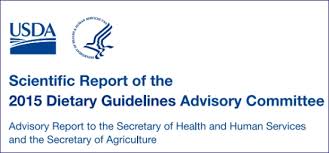
It’s a 574 document worth reading. If you know that’s not going to happen, here are some key points. Remember, everyone’s key points can be different based on their interest.
Conclusions:
Shortfall of nutrients: Vitamins A, D, E, C, folate, calcium, magnesium, fiber, and potassium. Of these, public health concerns are the shortfall of vitamins A, D, fiber and potassium. Adolescent and premenopausal women have a shortfall of iron.
Sodium and saturated fats are over consumed, as are refined grains and added sugar.
Comparing Guidelines to USDA food patterns, under consumption of key food groups are why the above nutrients are in the shortfall category. These groups are: vegetables, fruits, whole grains, and dairy.
Recommendation is education early in life.
The Guidelines include compare and contrast of three eating styles: Healthy U.S., Healthy Mediterranean, and Healthy Vegetarian. Similarities include a dietary pattern higher in vegetables, fruits, whole grains, low or non-fat dairy, seafood, legumes, nuts with moderate intake of alcohol, lower in red and processed meats, lower in sugar-added foods and drinks, and lower in refined grains.
Guidelines recommended diet for children and adults should be the above with “dietary plans tailored to the individuals biological and medical needs as well as socio-cultural preferences.”
Regarding food environments, Guidelines focused on four settings: community food access, childcare, schools and worksites-and their relationships to dietary intake and quality and weight status. They note that obesity prevention should be implemented in these settings. They also note, “ collaborative partnerships and strategic efforts are needed to translate evidence into action. Further work on restructuring the environment to facilitate healthy eating and physical activity, especially in high risk populations, is needed to advance evidence-based solutions that can be scaled up.”
Regarding food sustainability, the recommended diet is not only more health promoting, but it is “also associated with less environment impact.”
Regarding caffeine, there is limited evidence about high caffeine intake (greater than 400 mg/day) but children, adolescents and pregnant women should avoid caffeine. Less than 400 mg/day does not show adverse effects. 8 ounces of coffee is approximately 95 mg. It’s the additions (dairy/sugar, etc.) that make coffee a problem.
Sodium intake should be less than 2,300 mg/day, saturated fats should be less than 10% of total calories, and a maximum of 10% of total calories from added sugars per day. Guidelines recommend that “rather than focusing purely on reduction, emphasis should be placed on replacements and shifts in food intake and eating patterns.” Guidelines “supports efforts in labeling, and other campaigns to increase consumer awareness and understanding of sodium, saturated fats, and added sugars in foods and beverages.” They also “encourage the food industry to continue reformulating and making changes to certain foods and beverages to improve their nutritional profile.”
Guidelines recommend more physical activity. Engage in at least 2.5 hours a week of moderate-intensity aerobic physical activity, such as brisk walking, or 1.25 hours a week of vigorous-intensity aerobic physical activity. For weight control, at least 1 hour a day of moderate- to vigorous-intensity physical activity may be required. Engage children in at least 1 hour a day of moderate- to vigorous-intensity physical activity each day. Limit children’s screen time to no more than two hours per day. Adults should limit sedentary activity and replace it with aerobic and strengthening exercises. As needed, engage with qualified professionals in comprehensive lifestyle interventions to achieve maximal impact on healthy dietary and physical activity patterns and health outcomes. Get enough sleep! In Part D, Chapter 3, it is mentioned: “Suboptimal sleep patterns associated with today’s 29 busy lives also have been identified as a potential risk factor for poor dietary behaviors and body weight outcomes.”
Next are many pages of charts, dealing with consumption of foods and veggies. There are also pages and pages of disease state and diet. For a very brief synopsis, their dietary guidelines are best for prevention of improvement of various health issues. They give specifics on each, but, in essense: “The overall body of evidence examined by the 2015 DGAC identifies that a healthy dietary pattern is higher in vegetables, fruits, whole grains, low- or non-fat dairy, seafood, legumes, and nuts; moderate in alcohol (among adults); lower in red and processed meats; and low in sugar-sweetened foods and drinks and refined grains. Additional strong evidence shows that it is not necessary to eliminate food groups or conform to a single dietary pattern to achieve healthy dietary patterns. Rather, individuals can combine foods in a variety of flexible ways to achieve healthy dietary patterns, and these strategies should be tailored to meet the individual’s health needs, dietary preferences and cultural traditions. Current research also strongly demonstrates that regular physical activity promotes health and reduces chronic disease risk.”
Key Issues NOT addressed:
They have a long list of what they do not cover, but the Gut Biome/Pre and Probiotics is a major miss, in my opinion. The majority of our immune systems are in the gut, nutrients are absorbed in the gut, and much more. I’m sure this will be included in the 2020 Dietary Guidelines.
